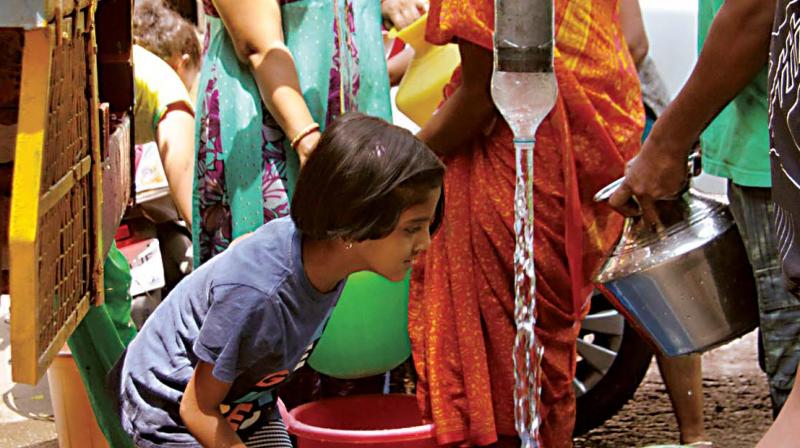Flush with solutions but running out of water

Every year, if the monsoon rainfall is below par, Karnataka goes through a brief period of alarm and worry, when levels at KRS dam drop. And each year, austerity measures are discussed, but as the rains have never yet failed the city completely, these moments of crisis-induced clarity soon slip away. Rainwater harvesting alone can supply 15 TMC of water to the city, which draws 19 TMC ft per annum from the Cauvery. However, with the crisis averted, it's likely the BWSSB, which has never implemented water rationing since its founding, will return to its laidback ways until the next crisis is upon us. At which time, it might be too late, warns Aknisree Karthik
The Bangalore Water Supply and Sewerage Board was formed in 1964. It was only in 2007 that the agency, the premier body for the city's water supply and sewage disposal, first considered implementing a mandatory water rationing programme. A trial was instituted in March that year, with electronic meters wired to shut off after the allotted amount of water was used. The programme was a technical failure. After that, apart from the rainwater harvesting programme, which has also been facing a failure of implementation, little has been done on the conservation front.
Now, with India looking at an acute water shortage, the Board has to come up with a concrete plan. At once. Falling levels in KRS dam had been a source of worry but recent rains in the Cauvery catchment, especially in Kodagu, has increased inflow to KRS. However, this is a short-term solution and with the magnitude of the crisis that looms, experts feel it's time to adopt austerity measures.
Water conservationist and founder, Friends of Lakes, says there is a 33 percent deficit in the state's rainfall, although the last two days' rain in the catchment area has been satisfactory. "What if the rains don't continue in this way?" he asks. "What will be BWSSB's way out then? They have to take up water rationing."
If water rationing is taken up, the BWSSB should ensure that it starts with bulk consumers, not the poor or those who use water judiciously, he says. He argues that the water board should be prepared and announce austerity measures when a crisis is anticipated, instead of springing it on people when it's too late.
Resorts, hotels and luxury apartments use thousands of litres jus to fill their swimming pools, depriving the poor of what might be their drinking water supply. "If the condition does arise, the poor people should not be touched. It's these consumers whose supply needs to be rationed."
The water board should also take steps to popularise the use of treated water for all non-potable purposes, says Prasad, adding that measures like banning construction in the city for five years is just foolishness.
Water tankers will suffer too, says Prasad, as many of them have tied up with officials to supply Cauvery water illegally. "Tankers fleecing citizens should be checked as the rich can afford to pay whatever price they demand but the poor might not," he explains.
Yes, rainwater can meet city’s needs
Rainwater harvesting is the most feasible solution at hand in Bengaluru, one that is not being given the importance it merits. Citizens agree that the government must harvest rain wherever it is possible to do so. BBMP, which announced that it will take up rainwater harvesting in all its parks, hasn't budget an inch on the plan since it was announced.
According to Vinod J, a resident of Banashankari, "When we built our house in 2014, we took every measure we could to save every drop of rainwater." He clarifies that they didn't install a rainwater harvesting system because it was mandatory, but simply in the interest of living an environment-friendly life. He argues that many still don't understand the importance of water. “The rainwater harvesting theme park at Jayanagar, run by BWSSB, has all sorts of models. You can use rainwater to recharge borewells, to water the garden, wash your car, even flush the toilets. This way, citizens can save thousands of litres of water and even reduce their water bills drastically," he says.
He added that if the government sets up rainwater harvesting plants in public spaces, where people can see them in action, it will motivate citizens to have them in their houses, too.
A BBMP official said they will take up rainwater harvesting at BBMP parks and are thinking of other open places as well.
QandA with Kemparamaiah, BWSSB Chief Engineer
‘Rainfall has improved now, there may not be a crisis this year’
Q: Water levels in Cauvery dams KRS, Kabini, Hemavathi and Harangi are less than satisfactory. Will the water board ration the water supply?
A: Initially rains were not so satisfactory in the Cauvery catchment area. The inflow into the dams was not good and there was talk of taking up water rationing if the rains do not pick up.
Q: Have the rains picked up enough in the Cauvery catchment area to defer austerity measures?
A: Yes, they have in the last two or three days, in the Cauvery catchment area and especially in Kodagu. This has increased inflow to the Cauvery dams.
Q: So will there be no water rationing?
A: All the four dams have enough water supply by July. We were worried at the start, that there would only be enough water to last us through July, leaving us with a shortage in August. Rainfall has improved now and the inflow is good. We expect the dam to be filled by July - August. To my knowledge, the board has not had to opt for water rationing at any time. We have been supplying water on alternate days, except if there is a maintenance issue. Looking at the rainfall over the last three days, however, we are hopeful that there will be no water crisis this year.

